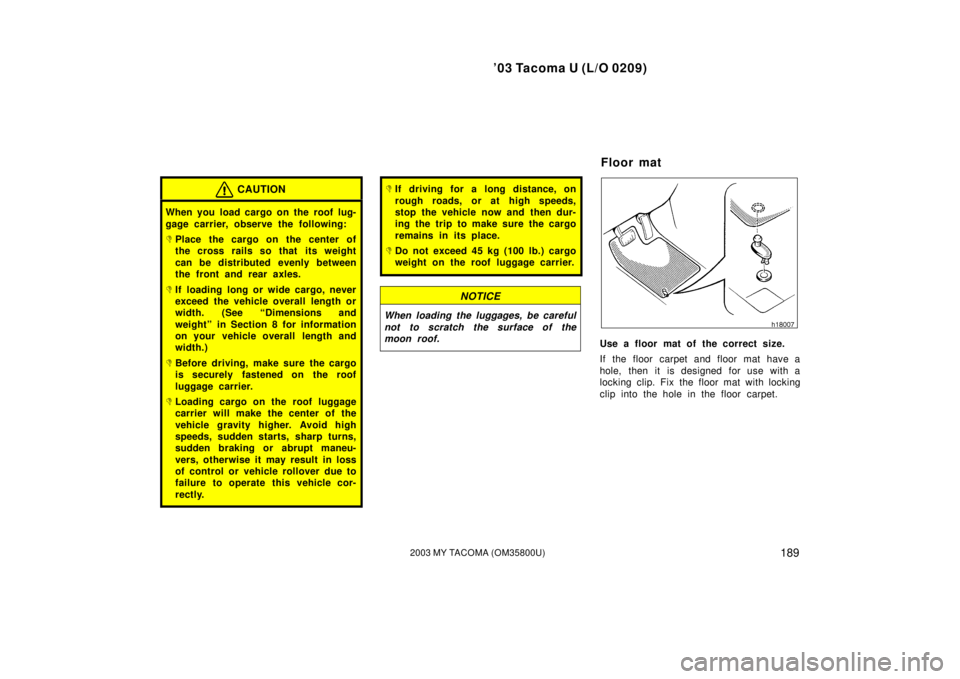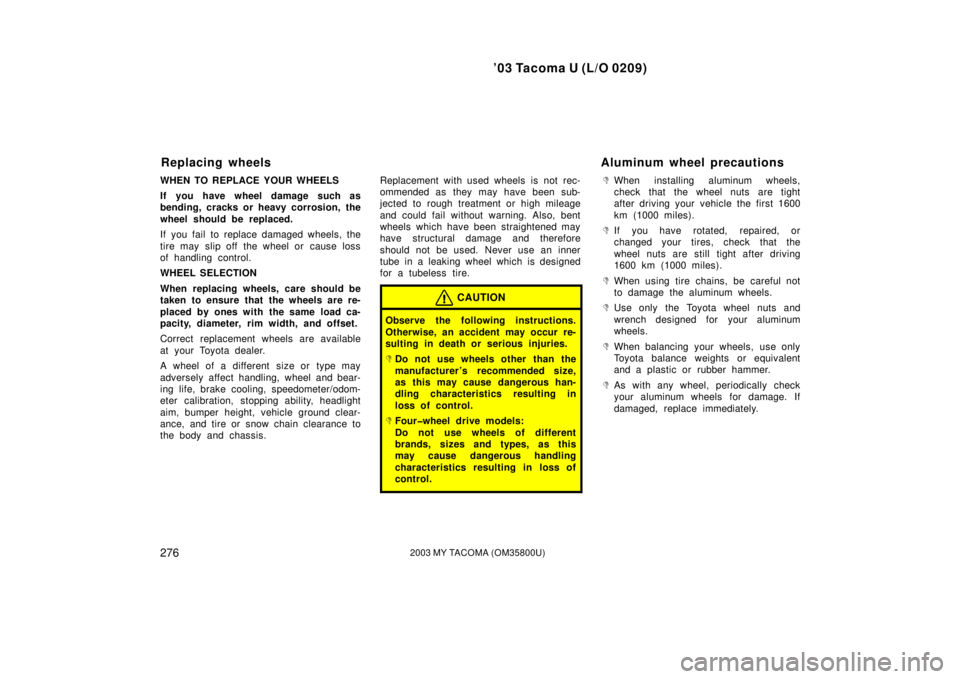Page 195 of 311

’03 Tacoma U (L/O 0209)
1892003 MY TACOMA (OM35800U)
CAUTION
When you load cargo on the roof lug-
gage carrier, observe the following:
�Place the cargo on the center of
the cross rails so that its weight
can be distributed evenly between
the front and rear axles.
�If loading long or wide cargo, never
exceed the vehicle overall length or
width. (See “Dimensions and
weight” in Section 8 for information
on your vehicle overall length and
width.)
�Before driving, make sure the cargo
is securely fastened on the roof
luggage carrier.
�Loading cargo on the roof luggage
carrier will make the center of the
vehicle gravity higher. Avoid high
speeds, sudden starts, sharp turns,
sudden braking or abrupt maneu-
vers, otherwise it may result in loss
of control or vehicle rollover due to
failure to operate this vehicle cor-
rectly.
�If driving for a long distance, on
rough roads, or at high speeds,
stop the vehicle now and then dur-
ing the trip to make sure the cargo
remains in its place.
�Do not exceed 45 kg (100 lb.) cargo
weight on the roof luggage carrier.
NOTICE
When loading the luggages, be careful
not to scratch the surface of the
moon roof.
Use a floor mat of the correct size.
If the floor carpet and floor mat have a
hole, then it is designed for use with a
locking clip. Fix the floor mat with locking
clip into the hole in the floor carpet.
Floor mat
Page 282 of 311

’03 Tacoma U (L/O 0209)
2762003 MY TACOMA (OM35800U)
WHEN TO REPLACE YOUR WHEELS
If you have wheel damage such as
bending, cracks or heavy corrosion, the
wheel should be replaced.
If you fail to replace damaged wheels, the
tire may slip off the wheel or cause loss
of handling control.
WHEEL SELECTION
When replacing wheels, care should be
taken to ensure that the wheels are re-
placed by ones with the same load ca-
pacity, diameter, rim width, and offset.
Correct replacement wheels are available
at your Toyota dealer.
A wheel of a different size or type may
adversely affect handling, wheel and bear-
ing life, brake cooling, speedometer/odom-
eter calibration, stopping ability, headlight
aim, bumper height, vehicle ground clear-
ance, and tire or snow chain clearance to
the body and chassis. Replacement with used wheels is not rec-
ommended as they may have been sub-
jected to rough treatment or high mileage
and could fail without warning. Also, bent
wheels which have been straightened may
have structural damage and therefore
should not be used. Never use an inner
tube in a leaking wheel which is designed
for a tubeless tire.
CAUTION
Observe the following instructions.
Otherwise, an accident may occur re-
sulting in death or serious injuries.
�Do not use wheels other than the
manufacturer ’s recommended size,
as this may cause dangerous han-
dling characteristics resulting in
loss of control.
�Four�wheel drive models:
Do not use wheels of different
brands, sizes and types, as this
may cause dangerous handling
characteristics resulting in loss of
control.
�When installing aluminum w
heels,
check that the wheel nuts are tight
after driving your vehicle the first 1600
km (1000 miles).
�If you have rotated, repaired, or
changed your tires, check that the
wheel nuts are still tight after driving
1600 km (1000 miles).
�When using tire chains, be careful not
to damage the aluminum wheels.
�Use only the Toyota wheel nuts and
wrench designed for your aluminum
wheels.
�When balancing your wheels, use only
Toyota balance weights or equivalent
and a plastic or rubber hammer.
�As with any wheel, periodically check
your aluminum wheels for damage. If
damaged, replace immediately.
Replacing wheels Aluminum wheel precautions
Page 294 of 311
’03 Tacoma U (L/O 0209)
2882003 MY TACOMA (OM35800U)
Dimensions
Regular cab models Xtra�cab models
Overall length
Overall height
∗ 8
Front tread
Rear tread Overall width
Wheelbase 4540 (178.7)
∗
1
4685 (184.4)∗25010 (197.2)∗1
5155 (203.0)∗2
1690 (66.5)
1765 (69.5)∗3, 41690 (66.5)
1625 (64.0)
∗4, 6
1615 (63.6)∗5, 6
1620 (63.8)∗4, 7
1630 (64.2)∗5, 7
3095 (121.9)
1450 (57.1)
1455 (57.3)
1455 (57.3) 1450 (57.1)
2625 (103.3) 1590 (62.5)
∗
3, 4
1605 (63.2)∗4
1615 (63.6)∗5
∗ 1
: Without rear step bumper∗2: With rear step bumper∗3: With 5VZ�FE engine∗4: With P235/55R16 tires∗5: With P205/75R15 tires∗6: With automatic transmission∗7: With manual transmission∗8: Unladen vehicle
TWO�WHEEL DRIVE MODELS EXCEPT PRE RUNNER mm (in.)
Page 295 of 311
’03 Tacoma U (L/O 0209)
2892003 MY TACOMA (OM35800U)
FOUR�WHEEL DRIVE MODELS AND PRE RUNNERmm (in.)
Regular cab modelsXtra�cab modelsDouble cab models
Overall length4685 (184.4)5155 (203.0)5155 (203.0)
Overall width1690 (66.5)∗
1
1785 (70.3)∗21690 (66.5)∗1
1785 (70.3)∗21785 (70.3)
Overall height∗41720 (67.7)∗1
1750 (68.9)∗21715 (67.5)∗1
1745 (68.7)∗2
1715 (67.5)∗1
1745 (68.7)∗2
1780 (70.1)∗1, 3
1810 (71.3)∗2, 3
Wheelbase2625 (103.3)3095 (121.9)3095 (121.9)
Front tread1460 (57.5)∗1
1500 (59.1)∗21460 (57.5)∗1
1500 (59.1)∗21460 (57.5)∗1
1500 (59.1)∗2
Rear tread1455 (57.3)∗1
1495 (58.9)∗21455 (57.3)∗1
1495 (58.9)∗21455 (57.3)∗1
1495 (58.9)∗2
∗1: With P225/75R15 tires∗2: With P265/70R16 tires∗3: With roof rails∗4: Unladen vehicle
Page 306 of 311

’03 Tacoma U (L/O 0209)
3002003 MY TACOMA (OM35800U)
If you believe that your vehicle
has a defect which could cause a
crash or could cause injury or
death, you should immediately in-
form the National Highway Traffic
Safety Administration (NHTSA) in
addition to notifying Toyota Motor
Sales, U.S.A., Inc. (Toll�free:
1�800�331�4331).
If NHTSA receives similar com-
plaints, it may open an investiga-
tion, and if it finds that a safety
defect exists in a group of ve-
hicles, it may order a recall and
remedy campaign. However,
NHTSA cannot become involved
in individual problems between
you, your dealer, or Toyota Motor
Sales, U.S.A., Inc.To contact NHTSA, you may ei-
ther call the Auto Safety Hotline
toll�free at 1�800�424�9393 (or
366�0123 in Washington, D.C.
area) or write to: NHTSA, U.S.
Department of Transportation,
Washington, D.C. 20590. You can
also obtain other information about
motor vehicle safety from the Hot-
line.This information has been prepared in ac-
cordance with regulations issued by the
National Highway Traffic Safety Adminis-
tration of the U.S. Department of Trans-
portation. It provides the purchasers and/
or prospective purchasers of Toyota
vehicles with information on uniform tire
quality grading.
Your Toyota dealer will help answer any
questions you may have as you read this
information.
DOT quality grades—All passenger car
tires must conform to Federal Safety
Requirements in addition to these
grades. Quality grades can be found
where applicable on the tire sidewall
between tread shoulder and maximum
section width. For example: Treadwear
200 Traction AA Temperature A
Reporting safety defects for
U.S. owners
Uniform tire quality grading